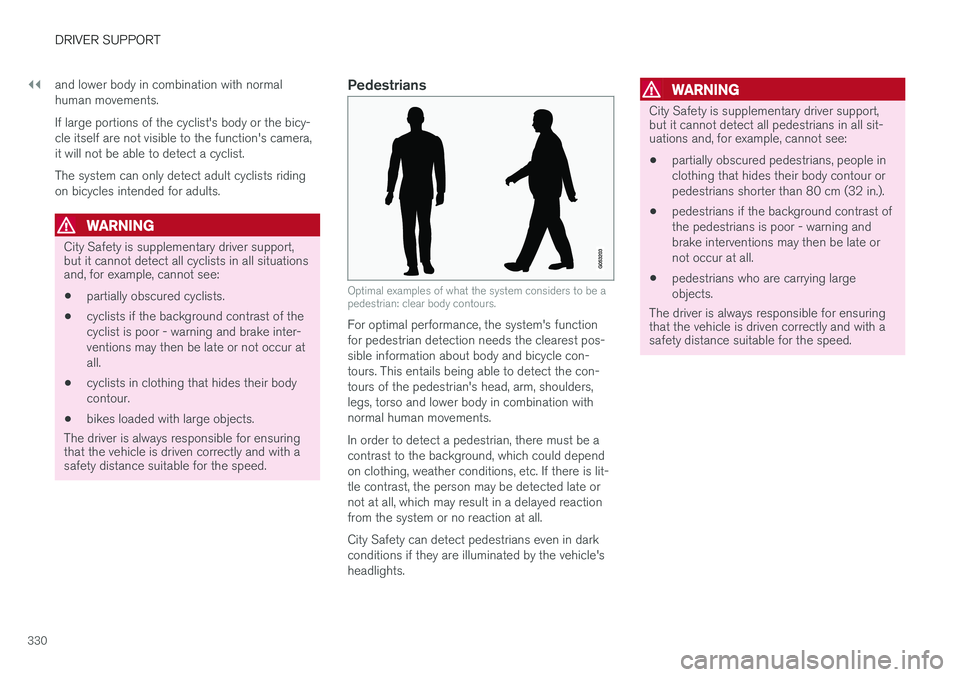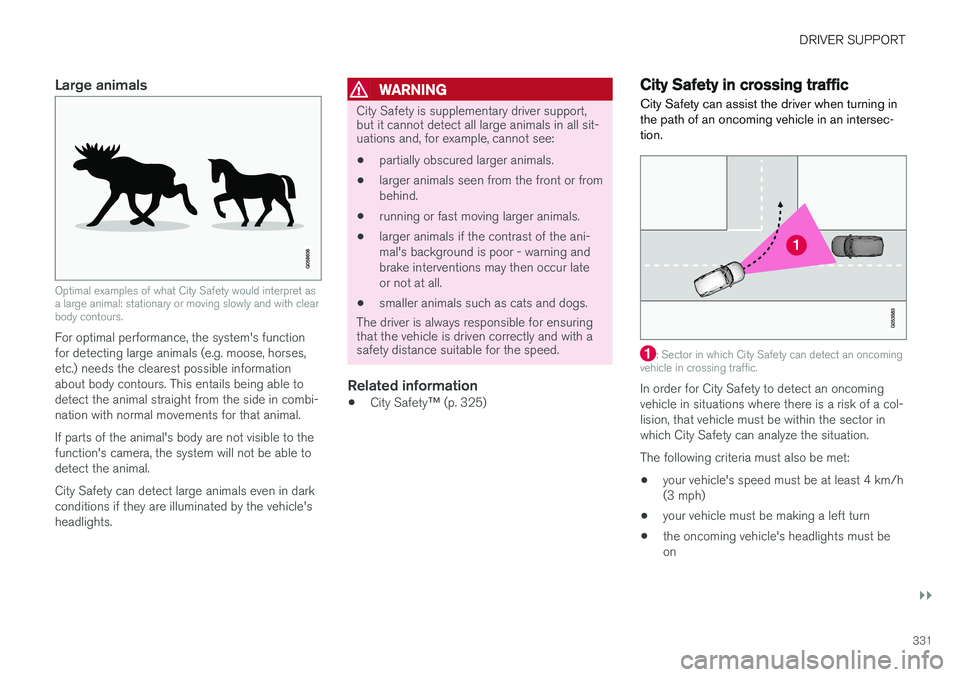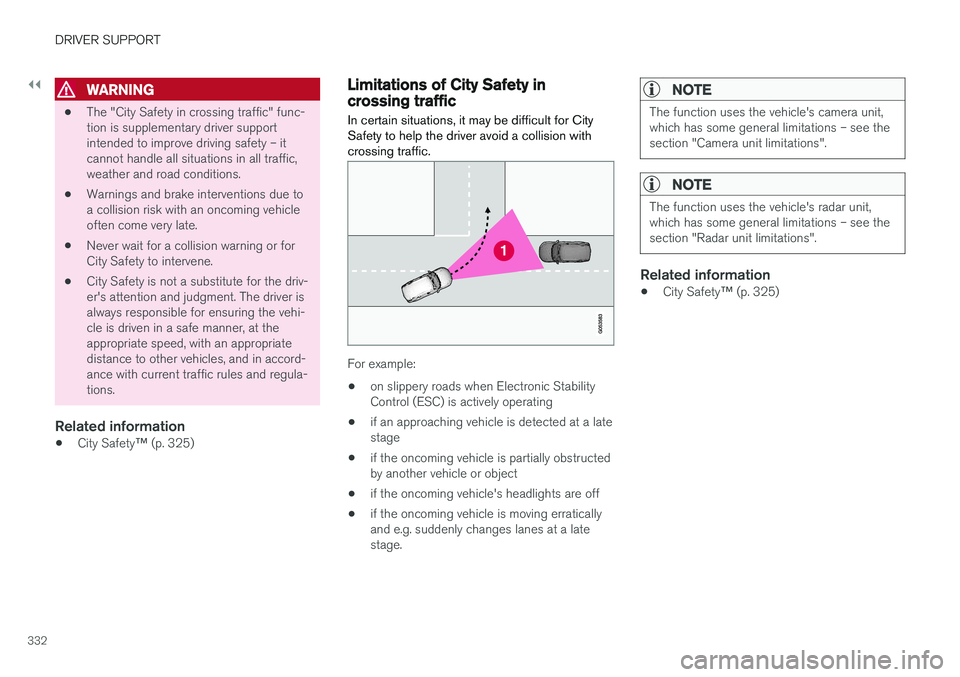2018 VOLVO XC60 T8 headlights
[x] Cancel search: headlightsPage 332 of 674

||
DRIVER SUPPORT
330and lower body in combination with normal human movements. If large portions of the cyclist's body or the bicy- cle itself are not visible to the function's camera,it will not be able to detect a cyclist. The system can only detect adult cyclists riding on bicycles intended for adults.
WARNING
City Safety is supplementary driver support, but it cannot detect all cyclists in all situationsand, for example, cannot see:
• partially obscured cyclists.
• cyclists if the background contrast of the cyclist is poor - warning and brake inter-ventions may then be late or not occur atall.
• cyclists in clothing that hides their bodycontour.
• bikes loaded with large objects.
The driver is always responsible for ensuring that the vehicle is driven correctly and with asafety distance suitable for the speed.
Pedestrians
Optimal examples of what the system considers to be a pedestrian: clear body contours.
For optimal performance, the system's function for pedestrian detection needs the clearest pos-sible information about body and bicycle con-tours. This entails being able to detect the con-tours of the pedestrian's head, arm, shoulders,legs, torso and lower body in combination withnormal human movements. In order to detect a pedestrian, there must be a contrast to the background, which could dependon clothing, weather conditions, etc. If there is lit-tle contrast, the person may be detected late ornot at all, which may result in a delayed reactionfrom the system or no reaction at all. City Safety can detect pedestrians even in dark conditions if they are illuminated by the vehicle'sheadlights.
WARNING
City Safety is supplementary driver support, but it cannot detect all pedestrians in all sit-uations and, for example, cannot see:
• partially obscured pedestrians, people in clothing that hides their body contour orpedestrians shorter than 80 cm (32 in.).
• pedestrians if the background contrast ofthe pedestrians is poor - warning andbrake interventions may then be late ornot occur at all.
• pedestrians who are carrying largeobjects.
The driver is always responsible for ensuring
that the vehicle is driven correctly and with a safety distance suitable for the speed.
Page 333 of 674

DRIVER SUPPORT
}}
331
Large animals
Optimal examples of what City Safety would interpret as a large animal: stationary or moving slowly and with clearbody contours.
For optimal performance, the system's function for detecting large animals (e.g. moose, horses,etc.) needs the clearest possible informationabout body contours. This entails being able todetect the animal straight from the side in combi-nation with normal movements for that animal. If parts of the animal's body are not visible to the function's camera, the system will not be able todetect the animal. City Safety can detect large animals even in dark conditions if they are illuminated by the vehicle'sheadlights.
WARNING
City Safety is supplementary driver support, but it cannot detect all large animals in all sit-uations and, for example, cannot see:
• partially obscured larger animals.
• larger animals seen from the front or from behind.
• running or fast moving larger animals.
• larger animals if the contrast of the ani-mal's background is poor - warning andbrake interventions may then occur lateor not at all.
• smaller animals such as cats and dogs.
The driver is always responsible for ensuring that the vehicle is driven correctly and with asafety distance suitable for the speed.
Related information
• City Safety
™ (p. 325)
City Safety in crossing traffic
City Safety can assist the driver when turning in the path of an oncoming vehicle in an intersec-tion.
: Sector in which City Safety can detect an oncoming
vehicle in crossing traffic.
In order for City Safety to detect an oncoming vehicle in situations where there is a risk of a col-lision, that vehicle must be within the sector inwhich City Safety can analyze the situation. The following criteria must also be met:
• your vehicle's speed must be at least 4 km/h (3 mph)
• your vehicle must be making a left turn
• the oncoming vehicle's headlights must beon
Page 334 of 674

||
DRIVER SUPPORT
332
WARNING
•The "City Safety in crossing traffic" func- tion is supplementary driver supportintended to improve driving safety – itcannot handle all situations in all traffic,weather and road conditions.
• Warnings and brake interventions due toa collision risk with an oncoming vehicleoften come very late.
• Never wait for a collision warning or forCity Safety to intervene.
• City Safety is not a substitute for the driv-er's attention and judgment. The driver isalways responsible for ensuring the vehi-cle is driven in a safe manner, at theappropriate speed, with an appropriatedistance to other vehicles, and in accord-ance with current traffic rules and regula-tions.
Related information
•
City Safety
™ (p. 325)
Limitations of City Safety incrossing traffic
In certain situations, it may be difficult for City Safety to help the driver avoid a collision withcrossing traffic.
For example:
• on slippery roads when Electronic Stability Control (ESC) is actively operating
• if an approaching vehicle is detected at a latestage
• if the oncoming vehicle is partially obstructedby another vehicle or object
• if the oncoming vehicle's headlights are off
• if the oncoming vehicle is moving erraticallyand e.g. suddenly changes lanes at a latestage.
NOTE
The function uses the vehicle's camera unit, which has some general limitations – see thesection "Camera unit limitations".
NOTE
The function uses the vehicle's radar unit, which has some general limitations – see thesection "Radar unit limitations".
Related information
•
City Safety
™ (p. 325)
Page 420 of 674

||
STARTING AND DRIVING
418
ModeFunctions
II •The headlights illuminate.
• Warning/indicator lights illumi- nate for 5 seconds.
• A number of other systems areactivated. However, seat and rearwindow heating can only be acti-vated when the engine is running.
This ignition mode uses a lot ofcurrent from the battery andshould be avoided whenever pos-sible!
A Also activated when the door is opened.
Related information
• Starting the vehicle (p. 414)
• Adjusting the steering wheel (p. 193)
• Jump starting using another battery (p. 459)
• Selecting ignition mode (p. 418)
Selecting ignition mode
The vehicle's ignition can be put in various modes (levels) to make different functions availa-ble.
Selecting an ignition mode
Start knob in the tunnel console.
• Ignition mode 0
- Unlock the vehicle and
keep the remote key in the passenger com- partment.
NOTE
To set level I or II without engine start – do
not depress the brake pedal (or clutch pedal
for vehicles with manual transmission) when selecting this ignition mode.
• Ignition mode I
- Turn the start knob clock-
wise and release it. The control will automati- cally return to the original position.
• Ignition mode II
- Turn the start knob clock-
wise and hold it there for approx. 5 seconds.Release the knob, which will automaticallyreturn to its original position.
• Back to ignition mode 0
- To return to igni-
tion mode 0 from mode I and II, turn the start
knob clockwise and release it. The controlwill automatically return to the original posi-tion.
Related information
• Starting the vehicle (p. 414)
• Switching off the vehicle (p. 416)
• Ignition modes (p. 417)
• Adjusting the steering wheel (p. 193)
• Jump starting using another battery (p. 459)
Page 461 of 674

STARTING AND DRIVING
}}
459
Battery drain The electrical functions in the vehicle drain the battery to varying degrees. Avoid using ignitionmode II when the engine is switched off. Use
ignition mode I instead, as this uses less electri-
cal current.
Note that certain accessories may also drain power from the electrical system. Do not usefunctions that use a lot of electrical current whenthe engine is turned off. Examples of such func-tions are:
• blower
• headlights
• windshield wipers
• audio system (especially at high volume).
If the starter battery voltage is low, a message isshown in the driver display. The vehicle's energy-saving function will then turn off or reduce certainfunctions, such as the blower and/or the audio system.
–Charge the battery by starting the engine and let it run for at least 15 minutes (drivingcharges the battery faster than letting theengine idle).
Related information
• Start battery (p. 605)
• Ignition modes (p. 417)
Jump starting using another battery
If the start battery is discharged, current from another battery can be used to start the vehicle.
Jumper cable connecting points.
CAUTION
The charging point of the vehicle is only intended for jump starting the vehicle in ques-tion. The charging point is not intended forjump-starting another vehicle. Using thecharging point to start another vehicle couldcause a fuse to blow, which would cause thecharging point to stop working.
If a fuse has blown, 12 V Battery Fuse failure
Service required will be displayed in the instru-
ment panel. Volvo recommends contacting an authorized Volvo workshop. To avoid short circuits or other damage, the fol-lowing steps are recommended when jump star-ting the battery:
Page 591 of 674

MAINTENANCE AND SERVICE
}}
589
Periodic maintenance helps minimize
emissions
NOTE
•Refer to your Service and Warranty Book- let for a comprehensive service and main-tenance schedule up to 240,000 km(150,000 miles). This program containsinspections and services necessary forthe proper function of your vehicle andincludes components that affect vehicleemissions.
• The Warranty and Service Records Infor-mation booklet also contains detailedinformation concerning the warrantiesthat apply to your vehicle.
On-board Diagnostic SystemOBD II is part of your vehicle's computerized engine management system. It stores diagnosticinformation about your vehicle's emission con-trols. It can light the Check Engine light (MIL) if itdetects an emission control "fault." A "fault" is acomponent or system that is not performingwithin an expected range. A fault may be perma-nent or temporary. OBD II will store a messageabout any fault.
Emission inspection readiness
How do states use OBD II for emission
inspections?
Many states connect a computer directly to a vehicle's OBD II system. The inspector can thenread "faults." In some states, this type of inspec-tion has replaced the tailpipe emission test.
How can my vehicle fail OBD II emission
inspection?
Your vehicle can fail OBD II emission inspection for any of the following reasons:
• If your Check Engine (MIL) light is lit, yourvehicle may fail inspection.
• If your vehicle's Check Engine light was lit,but went out without any action on your part,OBD II will still have a recorded fault. Yourvehicle may pass or fail, depending on theinspection practices in your area.
• If you had recent service that required dis-connecting the battery, OBD II diagnosticinformation may be incomplete and "notready" for inspection. A vehicle that is notready may fail inspection.
How can I prepare for my next OBD II
emission inspection?
• If your Check Engine (MIL) light is lit - or was lit but went out without service, have your vehicle diagnosed and, if necessary, servicedby a qualified Volvo technician.
• If you recently had service for a lit CheckEngine light, or if you had service thatrequired disconnecting the battery, a periodof driving is necessary to bring the OBD IIsystem to "ready" for inspection. Two half-hour trips of mixed stop-and-go/highwaydriving are typically needed to allow OBD II toreach readiness. Your Volvo retailer can pro-vide you with more information on planning atrip.
• Maintain your vehicle in accordance with yourvehicle's maintenance schedule.
Owner maintenancePeriodic maintenance requirements and intervalsare described in your vehicle's Warranty andService Records Information booklet. The following points can be carried out between the normally scheduled maintenance services.
Each time the car is refueled:
•Check the engine oil level.
• Clean the windshield, windshield wipers, headlights, and taillights.
Page 605 of 674

MAINTENANCE AND SERVICE
* Option/accessory.603
Unscrew the cover in the plastic covering.
Unscrew the expansion tank cap and fill coolant as needed. The level should not exceed the yellow MAX mark inside the
expansion tank.
Put the components back in place in the reverse order.
CAUTION
• Mix the coolant with water of acceptable quality. If you are unsure of the quality ofthe water, use a Volvo-recommendedpremixed coolant.
• Make sure the coolant mixture is 50%water and 50% coolant.
• Only use coolants with corrosion protec-tion recommended by Volvo.
• To help ensure sufficient corrosion pro-tection in the system, only use new cool-ant when replacing larger components inthe cooling system.
• Never run the engine unless the coolingsystem is properly filled. An improperlyfilled cooling system could lead to hightemperatures and cracks in the cylinderheads.
• High levels of chlorine, chlorides andother salts may cause corrosion in thecooling system.
Related information
•Engine compartment overview (p. 599)
• Coolant specifications (p. 653)
Replacing bulbs
Halogen headlights are not available on all mod- els and markets. Contact a Volvo retailer formore information. LED 13
bulbs must be replaced by a workshop.
An authorized Volvo workshop is recommended.
NOTE
For information on lights not mentioned in this article, contact a Volvo dealer or a certi-fied Volvo service technician.
NOTE
Exterior lighting such as headlights and tail- lights may develop temporary condensationon the inside of the lens. This is normal. Allexterior lighting is designed to resist this.Condensation is normally vented out of thelamp housing once the light has been lit forsome period of time.
NOTE
Bulbs for active curve lighting * contain traces
of mercury and should therefore always be submitted to a certified Volvo service techni-cian.
Related information
• Bulb specifications (p. 604)
Page 606 of 674

MAINTENANCE AND SERVICE
604
Bulb specifications The following specifications apply to the bulbs in the halogen headlights. If you are experiencing problems with any other lights, contact a workshop14
.
FunctionWAType
Low beams 55 H11
High beams 65 H9
Front turn signal 24 PWY24WDaytime running light/ parking light, front 21/5 W21/5W
A
Watt
Related information
• Replacing bulbs (p. 603)
13
LED (Ligth Emitting Diode)
14 An authorized Volvo workshop is recommended.